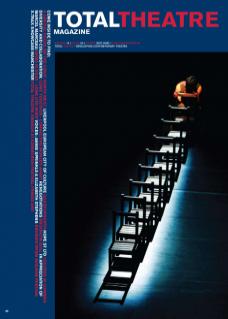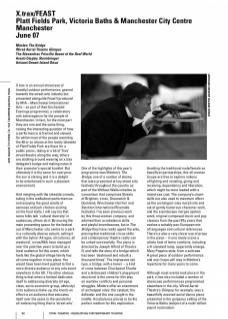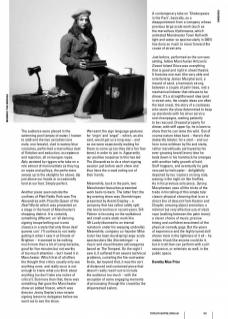X.trax is an annual showcase of (mostly) outdoor performance, geared towards the street arts industry but presented alongside Feast! (produced by MIA – Manchester International Arts – as part of their Enchanted Evenings programme), a celebratory arts extravaganza for the people of Manchester. In fact, for the most part they are one and the same thing, raising the interesting question of how a performance is framed and viewed. So whilst most of the people watching the 40 or so shows at the lovely lakeside of Platt Fields Park are there for a public picnic, taking in a bit of ‘free’ street theatre along the way, others are strolling around wearing an x.trax delegate’s badge and making notes in their promoter’s special booklet. But ultimately it is the same for everyone: the sun is shining and it is a delight to be entertained in such a pleasant environment.
And mingling with the lakeside crowds, taking in the walkabout performances and enjoying the good smells of samosas and jerk chicken sizzling on the food stalls, I will say too that some folks talk ‘cultural diversity’ in audiences; others do it. By moving the main presenting space for the festival out of Manchester city centre to a park in a culturally diverse suburb, selling it with the byline ‘All ages, all cultures, all weekend’, x.trax/MIA have managed over the past few years to build up a local audience for this event, which feels like the global village family has all come together in one place. You would have been hard pushed to find a more diverse audience at any arts event anywhere in the UK. The other obvious thing is that when a festival dedicates itself to addressing diversity (of age, class, socio-economic group, ethnicity) in its audience make-up, the knock-on effect is an audience that educates itself over the years to the wonderful all-embracing thing that is ‘street arts’.
One of the highlights of this year’s programme was Mimbre’s The Bridge, one of a number of shows that were presented at key street arts festivals throughout the country as part of the Without Walls initiative (a consortium that comprises Streets of Brighton, x.trax, Greenwich & Dockland, Winchester Hat Fair and Stockton International Riverside festivals). I’ve seen previous work by this three-woman company, and admired their acrobalance skills and playful inventiveness, but in The Bridge they have really upped the ante, proving that traditional circus skills and contemporary theatre really can be united successfully. The piece is directed by Joseph Alford of Theatre O, and tells the story of a bridge which has been ‘destroyed and rebuilt a thousand times’. The impressive set (yes, a bridge, with a tower – a kind of cross between Checkpoint Charlie and a distressed children’s playground structure) is the arena for this play on wartime conflicts and personal struggles. Mimbre offer an enactment of archetypal roles: the catalyst, the defender and the one caught in the middle. Acrobalance proves to be the perfect medium for this exploration.
Avoiding the traditional male/female as base/flyer partnerships, this all-woman troupe are free to explore notions of fighting and resisting, giving and receiving, dependency and liberation, which might be more loaded with a mixed-sex cast. The company’s clown skills are also used to maximum effect as the archetypal roles morph into and out of gently humorous character work, and the soundscape merges spoken word, original composed music and pop classics from the past fifty years that evokes a suitably pan-European mix of languages and cultural references. There’s a also a very clever use of props in the piece – in one lovely scene a whole host of home comforts, including a lit standard lamp, apparently emerge, Mary Poppins style, from a suitcase. A great piece of outdoor performance and one I hope will stay in Mimbre’s repertoire for many years to come.
Although most events took place in the park, x.trax also included a number of showcase performances programmed elsewhere in the city. Wired Aerial Theatre’s Glimpse, for example, was a beautifully enacted aerial dance piece presented in the gorgeous setting of the Victoria Baths (subject of a multi-million pound restoration).
The audience were placed in the swimming pool (empty of water, I hasten to add) and the two aerialists (one male, one female), clad in watery blue costumes, performed a marvellous duet of flirtation and seduction, acceptance and rejection, all on bungee ropes. Ably assisted by riggers who take on a role almost of marionettists as they tug on ropes and pulleys, the performers swoop up to the skylights far above, dip just above our heads or occasionally land at our feet. Simply perfect.
Another piece seen outside the confines of Platt Fields Park was The Alexandras with Priscilla Queen of the Deaf World, which was presented on a stage in the heart of Manchester’s shopping district. It is certainly something different: an ‘all dancing signing troupe belting out iconic classics in a style that only three deaf queens can’. I’ll confess to not really getting it when I saw it at Streets of Brighton – it seemed to be nothing much more than a bit of camp karaoke, good for five minutes but not worthy of too much attention – but I loved it in Manchester. Which first of all offers the thought that critics usually only see anything once, and really once is not enough to know what you think about anything (so don’t take any notice of critics!). But more than that, there was something that gave the Manchester show an added frisson, which was director Jenny Sealey’s two-minute signing lesson to delegates before we went out to see the show.
We learnt the sign language gestures for ‘virgin’ and ‘angel’ – which, as she said, would get us a long way – and so we were expectantly waiting for these to come up (as they did a fair few times) in order to join in. Apparently our positive response to this has led The Alexandras to do a short signing session just before each show and thus have the crowd eating out of their hands.
Meanwhile, back in the park, two Manchester favourites presented work back-to-back. The latter first: the big evening show was Stormbringer, presented by Avanti Display – a company that has rather oddly split into two branches in recent years. Bill Palmer is focusing on the walkabout and small-scale static work like Mr Lucky (doomed to an eternal rainstorm under his weeping umbrella). Meanwhile, company co-founder Mike Lister has been developing large-scale spectaculars like Stormbringer – a music and visual theatre extravaganza based on The Tempest. On the night I saw it, it suffered from severe technical problems, curtailing the fire-and-water finale, but beyond that, it was the sort of distanced and contained piece that doesn’t really reach out to include the audience too much – with the exception of some engaging moments of processing through the crowd by the shipwrecked sailors.
A contemporary take on ‘Shakespeare in the Park’, basically, so a disappointment from a company whose previous large scale work (such as the marvellous Hydromania, which animated Manchester Town Hall with light and water so spectacularly in 2001) has done so much to move forward the cause of street arts.
Just before, performed as the sun was setting, fellow Manchurian Artizani’s Desert Island Discs was everything that is good and right in street theatre. It features one man (the very able and entertaining James Macpherson), a mound of sand, a hammock strung between a couple of palm trees, and a mechanical lobster that refuses to be dinner. It’s a straightforward idea (and in street arts, the simple ideas are often the best ones), the story of a castaway who starts the show determined to keep up standards with his silver service and champagne, waiting patiently to be rescued. Dressed properly for dinner, with stiff upper lip, he is keen to show that he can tame the wild. But of course nature bites back – there’s that dastardly lobster, for a start – and our hero turns wildman by fits and starts, rather marvellously portrayed by his ever-growing beard (every time he beds down in his hammock he emerges with another hefty growth of hair). Stuff happens, and eventually he gets rescued by helicopter – delightfully depicted by toy ’copters on long rods, waving in the night air like fireflies. As in his previous solo piece, Syrovy, Macpherson uses all the tricks of the trade in his telling of this simple tale: classic physical clowning that is on a direct line of descent from Keaton and Chaplin; amusing object animation; a minimal but very effective use of slack rope (walking between the palm trees); a clever choice of music; precise timing and confident enactment of the physical comedy gags. But the years of experience and the highly tuned skill shows most in the lightness of it all – he makes it look like anyone could do it, but in truth few can perform with such assurance, or entertain so well, in the public space.


